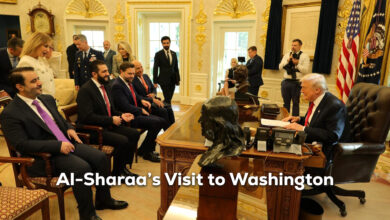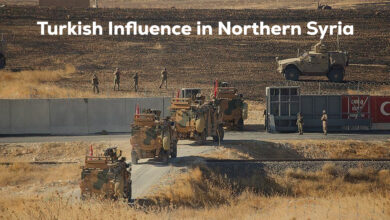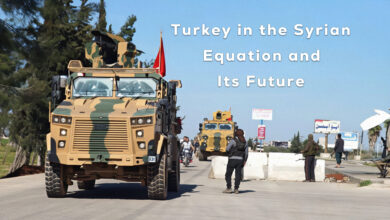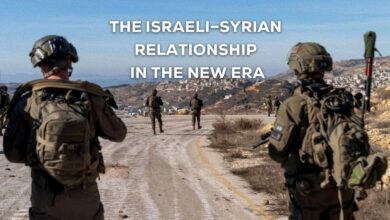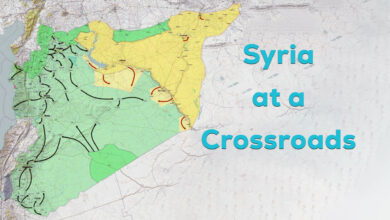Behind Russian-Turkish silence in Syria’s north

Parties to the conflict in Syria and guarantors of Astana process are preparing to launch the 16th round of the meetings in light of reports about Qatar’s involvement, which had a long history with the Syrian crisis.
Turkish and opposition media outlets circulated points called as the Russian proposals to the Turks regarding the de-escalation zone in Idlib, which are three:
First, Russia’s failure to include an internationally acceptable monitoring mechanism in the Russian offer plan presented to the Turkish side, led Turkey to consider that this plan will make the mistakes of previous agreements. Turkey suggested including a role for the UN in monitoring the ceasefire, provided that it is Turkey and Russia have a supervisory role over the monitoring mechanism between them related to dealing with the violations take place.
Second, the withdrawal of the Syrian regime forces from the areas they controlled after Sochi agreement will be discussed. The Russian proposal provides for the deployment of the Russian military police in these areas under the supervision of the regime’s government.
The third point relates to the general formula for a ceasefire presented by Russia, as Russia presented the ceasefire draft as a truce which is renewed every six months to a year, but Turkey rejected and preferred to be a permanent ceasefire.
Russian-Turkish moves
Undoubtedly, the Russian forces are trying, as much as possible, to control matters in Syria and put the US in a particularly embarrassing position regarding the fate of Idlib governorate, which, during the first quarter of this year, had become the focus of attention of many US media outlets and US-backed organizations. Perhaps, these indicators prompted Russia to make concessions to Turkey regarding the region, most notably the return to the borders of Sochi Agreement and the return of the Turkish forces and the Turkish-backed armed opposition factions to the regions east of Idlib and north of Hama, the matter reveals why Turkey established a military base in the vicinity of Jisr al-Shughur in April, after stopping the construction of observation points over the past 60 days.
On the other hand, and in the context of not shedding light on the moves that Idlib governorate might witness during the coming period, Russian military bases and a number of Russian-backed forces withdrew from Idlib and the northern countryside of Aleppo, and transferred to the southern countryside of Raqqa to start a military campaign against ISIS remnants in the Syrian Badia. It also brought in the Eighth Brigade in addition to members from several governorates and send them to Raqqa to launch the battle to comb the desert.
The Russian moves in the region coincided with large-scale military operations by the Turkish army, which had directly targeted Tel Rifaat, Ain Issa and Tel Tamr, in addition to the Turkish state’s continuing operations of digging and expanding trenches on the borders separating the Syrian and Turkish territories in the areas west of Kobani, amidst preparation by the Turkish media on the necessity of continuing the Turkish army’s operations in Syria and targeting the Syrian Democratic Forces.
At the same time the Russian forces launched a series of raids in April targeting areas north of Ain Issa, Idlib and al-Bab, east of Aleppo, which were carried out by Russian warplanes. According to what was reported by the Russian media, these raids were based on information about preparations by opposition groups to target the Turkish bases and the Turkish army.
Possible scenarios
First: Undoubtedly, the statements made by Turkey about its full readiness to support Ukraine in any war it might fight with any military force, come in the context of pressure on Russia in order to achieve some interests in favor of Turkey. So, it is possible that Russia has given up some northwestern regions of Syria in exchange for Turkish non-intervention in the Ukrainian crisis, in addition to the re-expansion of the Turkish forces and the Turkish-backed mercenary factions in the southern and western countryside of Idlib and the cessation of military operations.
Second: In light of the preparations that the regime is seeking to hold elections on all of the Syrian territories, the Russian forces may seek, through the Turks, to increase pressure on the Syrian Democratic Council and the Syrian Democratic Forces, with the aim of clearing the way for setting up ballot boxes in the regions of northeastern Syria, the most prominent of which are Hasakah and Qamishli.
Third: Re-marketing Turkish goods inside Syria through the opening of the border crossings with the Turkish side, which number three in northwestern Syria, through which the Syrian economy will be revitalized as well as increasing trade exchange between the Syria and Turkey at a time when Russia seeks to win Gulf states’ friendliness and impose further restrictions on Iran in Syria by joining Iranian militias in the Badia battles that the Russian forces are preparing to start with.
